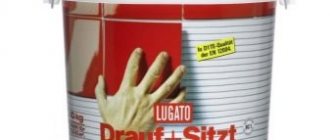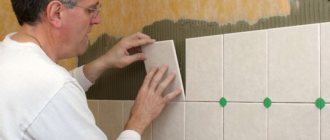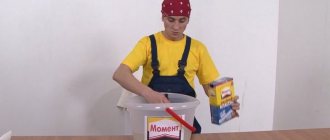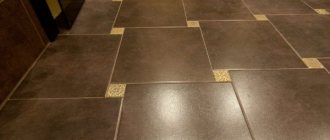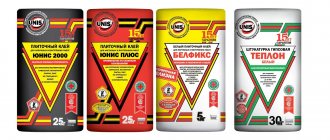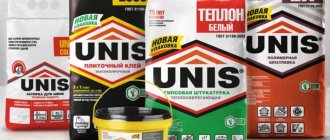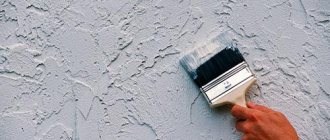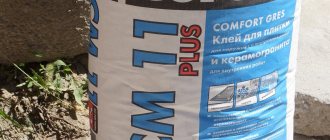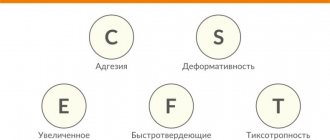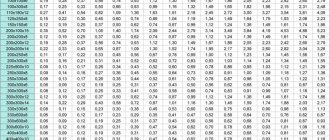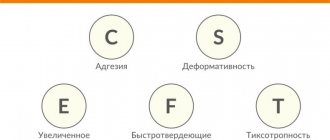The Unis company is a large domestic company that produces building materials. The corporation's range of branded products includes Eunice tile adhesive; it is used for work in kitchens, bathrooms, swimming pools, verandas and other places where tiles are planned to be laid. Since the mixture has several varieties, to make the right choice, you should consider the characteristics of each item.
| Category | Name | Price | Customer Reviews |
| Frost-resistant tile adhesive Yunis for exterior work | Unis 2000 | 25 kg – 280 rub. | This brand of glue is of very high quality. Suitable for all types of finishing, if the weight does not exceed 400 grams for every 100 sq.cm. |
| Unis HiTech | 25 kg – 460 rub. | For external cladding of buildings above the basement, balconies, terraces, wet rooms. You can lay tiles or stone from top to bottom. | |
| Unis Granite | 25 kg – 440 rub. | Very thick and with excellent adhesion - used for large size and weight slabs. Remains “alive” for 3 hours. The consumption is high, but no preliminary preparation of the base is required. | |
| Unis Belfix | 25 kg – 540 rub. | The highest adhesion in the series - even large marble and stone are placed on Belfix. | |
| Yunis tile adhesive for heated floors | Unis Granite | 25 kg – 440 rub. | Withstands significant temperature changes, including prolonged freezing of the room and rising to a peak temperature of +70°C. |
| Unis Plus | 25 kg – 265 rub. | Good adhesion, slip resistance. Different installation methods - top to bottom, tile to tile. Designed for 100 freeze/defrost cycles. | |
| Unis Belfix | 25 kg – 540 rub. | Adhesive strength 1 MPa, withstands 75 cycles. Also suitable for damp rooms and open spaces. Designed for all types of tiles, porcelain stoneware, stone and other natural or artificial materials. | |
| Yunis tile adhesive for porcelain tiles | Unis Plus | 25 kg – 265 rub. | Refers to universal species. A durable base for laying ceramic tiles ensures high adhesion. |
| Unis 2000 | 25 kg – 280 rub. | Suitable for porcelain stoneware and tiles on any horizontal and vertical surfaces. The main feature is the leveling of differences up to 10 mm. | |
| Yunis tile adhesive for wet rooms - bathroom, pool | Unis Pool | 25 kg – 470 rub. | In addition to the cement base binder, the composition contains antifungal components. Very high adhesion, holds well both indoors and in a water tank. |
| Unis FIX | 25 kg – 260 rub. | It is used for indoor work with normal and high humidity, in bathrooms and on heated balconies. Complete drying within 24 hours. | |
| Eunice tile adhesive for complex substrates | Unis Pool | 25 kg – 470 rub. | Suitable for all types of slabs, including heavy ones - up to 50 kg/sq.m. The improved formulation allows for installation in different ways without the risk of slipping. Withstands 100% humidity. Due to its viscosity, it perfectly equalizes differences of up to 10 mm. |
| Unis XXI | 25 kg – 190 rub. | Recommended for use together with Eunice primer. Made on a cement basis, it has excellent adhesion and frost resistance. |
What is good about Eunice glue?
The use of modern fillers improves resistance to moisture and cold, and increases the adhesion strength of the product to the base.
The glue holds well not only tiles, but also heavy natural stone. At the same time, masonry can be done on a variety of surfaces - from brick and concrete to plastered walls. The glue can be mixed not only by mechanized methods, but also manually, which makes it possible to use it at home. It takes about 180 minutes to use the solution, which is quite enough for laying the material in rooms of different sizes. The product is supplied in convenient packaging that is easy to transport in any car.
Main characteristics
- The composition can hold tiles weighing one hundred kilograms per square meter.
- The pot life of the adhesive is about three hours; it takes twenty minutes to lay the tiles, and ten minutes to adjust it. The composition will harden after a day, and you can safely walk on the tiles.
To dilute the product, packaged in a 25 kg bag, you will need 4-6 liters of water. In this case, masonry can be carried out at temperatures from +5C to +30C. If you apply a layer of glue 3-15 mm thick, the consumption of the product will be about four kilograms per square meter.
It is no coincidence that these adhesives are used to work with complex surfaces. They provide high adhesion strength, so installation can even be done using the top-down method.
Adhesives can also be used on heated surfaces, for example, on “warm floors” heated to a temperature of 40C.
Clay Eunice 2000
Purchased glue in original packaging can be stored for one year, observing the manufacturer's requirements for humidity and ambient temperature.
In terms of the combination of price and characteristics, Eunice adhesives are deservedly considered one of the best building materials on the market. VIDEO ON THE TOPIC
How to dilute and work with Eunice tile adhesive
The preparation of the Unis 2000 tile adhesive solution is carried out in accordance with the manufacturer’s recommendations, which are set out on the product packaging. Only clean containers and tools should be used.
Stages of dilution and use of Eunice glue:
1. Pour the dry mixture into a prepared container with clean water and stir until a homogeneous mass is obtained for 3-5 minutes.
2. Let stand for 3-5 minutes and mix again. When mixing, do not add more dry mixture or water to the composition.
3. The resulting solution must be used within 180 minutes.
Important information:
- Adhesive compositions should be used for cladding durable, non-deformable bases. Work should be carried out in dry conditions at air and base temperatures from +5C to +30C and relative air humidity not exceeding 75%.
- When performing external cladding, direct sunlight is not allowed on the cladding surfaces.
4. Using a trowel or spatula, apply the prepared adhesive solution with a thickness of 3 to 15 mm onto the prepared primed base or work surface and level it with a notched trowel. For large-format ceramic tiles, use a spatula with teeth of at least 8 mm.
When covering walls, the weight of large-format tiles should not exceed the weight indicated on the packaging.
5. Place the tile on the layer of glue and press down. Its inner surface should adhere tightly to the adhesive solution. When applying adhesive to substrates, the mortar mixture should be applied to an area that can be covered within 10 minutes.
We control the installation by level. If necessary, the position of the tiles can be adjusted within 10 minutes after installation. During the same period, the surface of the tiles and joints should be cleaned of excess glue.
Subsequent grouting of the seams of wall and floor tiles with Eunice Color colored grouts can be carried out 24 hours after tiling.
Eunice tile adhesive: step-by-step instructions
Let's look at the instructions for using Unis tile adhesive. To carry out finishing work at home without errors, follow the following steps one by one:
- Preparing the surface. We remove old remains of building materials and degrease the coating. Level the base. We prime with special compounds to ensure a high-quality screed.
- Mix the glue solution in strict accordance with the manufacturer's instructions. The vessel in which this operation is performed must be perfectly clean and dry. You can mix the solution manually or with a construction mixer.
- Apply glue using a trowel. The thickness of the layer and the size of the teeth of a notched trowel are selected taking into account the dimensions of the sides of the tile covering. We make sure that the Eunice tile adhesive is applied over the entire surface of the wall in the same thickness.
- We carry out serial installation. To do this, carefully press the tiles one by one onto the tile adhesive so that the coating is level in all respects. The optimal width of the joints is also determined by the dimensions of the tile covering. For convenience, we use crosses, rules and other specialized devices.
- If the tiles are laid on the floor, you can walk on them only after 24 hours.
Recommendations for selection and use
If you are planning to purchase Eunice adhesive for porcelain stoneware or other coatings in Moscow, we strongly recommend that you study some tips regarding choosing a product. So, always look at the expiration date of the product, it should not be expired. Otherwise, the tool will not be expected to fully perform the required functions.
In addition, the product should be purchased exclusively from trusted points of sale. It is important that specialist markets provide a product certificate upon request to guarantee high quality in accordance with established requirements. Pay attention to the storage conditions: if the seller does not comply with them, you risk buying a spoiled product.
Naturally, consult with the seller before purchasing. Study information about each type of tile adhesive from TM Yunis. Take your time, carefully select the mixture to avoid purchasing the wrong product.
You need to work with such products in strict accordance with the instructions from the manufacturer. Read the recommendations regarding preparation, thickness of the application layer and final hardening time of the solution.
By following the usual rules, you will be able to make a truly masterful renovation of the interior.
Data collection - what is needed for calculations?
In each individual case, the consumption of tile adhesive is influenced by many factors:
- type of base;
- type of tile;
- type of adhesive composition;
- application technology and craftsmanship.
It should be understood that you should start calculating only after you have decided on the type of tile and the quality of the base. Making calculations offhand, without having basic values, is fraught with a shortage of materials or large surpluses.
Let's start from the foundation. There is such a thing as thin-layer laying - it is possible if the surface on which the glue will be applied is very well leveled and has differences of no more than 3 mm. In this case, the norm is 5 mm of glue thickness, this is enough to adhere the tile and the base. The standard mixture consumption in this case is up to 5 kg per 1 square meter.
The adhesive mixture can also be used to remove unevenness - this is cheaper and faster than pre-preparing the floor, for example, pouring a screed. For thick-layer installation, special compounds are needed that can even out differences of up to 30 mm. Thick-layer laying is also necessary if the tile on the reverse side has a pronounced corrugated structure.
To save glue per 1 m2, it is also necessary to prime the base. Many people neglect this stage, not wanting to spend money on buying primer, but in this case they overpay for the amount of glue used. Where will it be spent? The soil serves to fill the pores in the base and provide strong adhesion to the materials. Without primer, the base absorbs a lot of glue, especially if the choice of composition has not been optimized for a specific type of base. So, brick absorbs much more moisture and glue than drywall. That is why manufacturers offer different compositions for different surfaces.
Factors affecting glue consumption
The first thing the mixture consumption depends on is the type of surface and its general condition. The smoother the wall and the fewer irregularities and cracks there are, the less glue is used. That is why professional builders recommend pre-preparing the base using a less expensive finishing material such as plaster.
In addition, the back side of the tile may also have an uneven surface, and then an additional layer of mortar is applied to it.
The next parameter that determines the required amount of glue is the material of both the wall and the tile itself.
Each material has its own porosity, depending on which it has a certain absorbency. For example, concrete walls absorb the least amount of mortar. To reduce the consumption of tile adhesive per 1 m2, the base is carefully treated before
Tiles are also made from different materials. The smallest amount of glue disappears on porcelain stoneware panels, the largest porosity is on cotto tiles.
The size of the panels also plays a role; the larger the tile, the thicker the layer should be.
Much depends on the installation method and the professionalism of the craftsmen. The more experienced the finisher, the thinner the layer of glue he can apply without losing the quality of the fastening.
What affects consumption?
There are quite a lot of factors on which the rate of consumption of tile adhesive per 1 m2 depends. And if calculating the squares of the surface area itself is not difficult, then calculating the glue consumption will require collecting some data. For the most accurate and correct calculation, it is necessary to take them all into account as objectively and correctly as possible:
The type and size of tiles or tiles chosen for finishing. Each material has varying degrees of porosity and density
More porous tiles will absorb more adhesive. Dense material, such as porcelain stoneware, practically does not absorb moisture due to its high density. But matte tiles are the most expensive in terms of the amount of adhesive solution per 1 m2.
The size of the tile plates also plays a big role. The larger the tile, the greater its mass. Therefore, it will be necessary to apply more adhesive to better fix the tiles to the surface.
Features of the surface on which installation is carried out. As is the case with the back side of the tile itself, the amount of adhesive solution applied depends on the degree of uniformity and evenness of the surface of the wall or floor. Changes, protrusions, cracks will require additional consumption of the composition. If the relief of a wall or floor is significantly uneven, it is advisable to carry out work to level the surface before laying the facing material.
The secret lies in the correct positioning of the spatula relative to the surface. The larger the angle, the more excess glue will be applied. The optimal spatula angle is approximately 40-45 degrees.
External conditions during work. This factor is especially important under changeable weather conditions, if work is carried out outdoors. If in most cases it is quite possible to maintain constant and optimal conditions for work in a room, then when working with a facade you will have to adapt to external factors beyond the control of the master.
You should also keep in mind that a concrete surface will require much less adhesive than a more porous brick or plaster surface. The PVC surface is also high-cost in terms of the amount of glue. When calculating the consumption of the adhesive solution, you will need to take this feature into account.
- Method and technology for laying ceramic tiles or tiles. If the facing material is laid in straight rows, glue costs will be significantly lower. When laying panels, mosaics, and patterns, the consumption of adhesive composition increases.
- Technology of applying adhesive composition. Experienced craftsmen are proficient in the most economical methods of applying the solution in terms of glue consumption. Moreover, the reduction in consumption does not come at the expense of the strength of the tile itself.
Installation should not be carried out at temperatures below +5 degrees. High humidity also has a detrimental effect on the quality of work. Too hot a temperature is also unacceptable. The maximum threshold at which it is possible to produce high-quality cladding is +35 degrees.
If these recommendations are not followed, for example, when working in rainy, cold weather, or, conversely, under the scorching sun, there is an almost one hundred percent chance that the glue will simply lose its properties. High-quality fixing of tiles to a surface, especially a vertical one, will be impossible. If the temperature is too high, the glue begins to harden even before application, which significantly reduces the time it takes to use the finished solution.
At low temperatures and excessive humidity indoors or outdoors, such important properties as viscosity and the speed of hardening of the adhesive suffer. If large, large tiles, such as clinker, are chosen for cladding, it will be almost impossible to fix them on a vertical surface under such conditions.
Choice
Unis adhesive is available on the market in several formats, each of which is suitable for a specific type of repair, material, temperature and many other factors. It is always written in the name of the glue or on its packaging what this or that type is suitable for.
Unis Plus
The scope of application of glue is very wide. Eunice Plus is suitable for repair work inside and outside the building, securely fixing it to the base.
The safe composition and the absence of a sharp unpleasant odor allows the adhesive solution to be used for cladding medical and children's institutions and houses.
Basic indicators:
- Adhesion – 1.25 MPa.
- The maximum withstand load is 100 kg/m2.
Scope of application – internal and external cladding, complex bases.
Unis 2000
Allows you to cover floors and walls without prior leveling, and fills unevenness and cracks well.
Withstands ceramic tiles and porcelain stoneware up to 60x60 in size.
Safe and hypoallergenic composition, suitable for use in children's institutions and hospitals.
Unis 21
Typically used for interior wall and floor cladding with standard size ceramic tiles. It is characterized by increased moisture resistance and is used in the renovation of bathrooms and kitchens.
Able to withstand small-sized porcelain stoneware slabs (up to 30x30).
Porcelain tiles with Yunis 21 glue should only be laid on the floor so that they are firmly pressed and the adhesion is strong.
Unis hitech
The Hitech adhesive mixture is highly durable and does not dry as quickly as other types. Allows you to lay it from top to bottom, and not just the standard method - it provides reliable adhesion to surfaces of any type.
Unis granite
From the name of the glue it is clear that its main purpose is to cover walls and floors with heavy materials: natural stone, porcelain stoneware.
Provides tight adhesion and is suitable for laying tiles on floors, walls, plinths, facades.
Dries quickly and prevents tiles from slipping. Adhesion index – 1.5 MPa.
Unis Belfix
Suitable for complex facing work, reliably holds natural stone, marble, granite, mosaic, porcelain stoneware. The main advantages are a high level of elasticity and frost resistance.
Often used for grouting joints, cladding the outside of a building, and decorating heated floors. The most expensive option presented.
For more information about frost-resistant glue, read the article - Frost-resistant glue for external use
Unis fix
Cheap glue that is rarely found in construction stores. In terms of strength characteristics, it is inferior to other types; it is usually used for cladding walls and floors with standard small tiles.
It repels moisture well and is suitable for cladding rooms with high humidity - kitchens, bathrooms.
Unis pool
Suitable for decoration, swimming pools, water tanks with ceramic tiles, mosaics, natural stone. Indoors can be used for cladding with high humidity, heated floors.
New tiles can be laid on old ones; they are also suitable for covering untreated surfaces. Fills cracks and uneven areas well.
What affects the consumption of tile adhesive
tile size – large tiles require a thicker layer. The thickness is adjusted by the height of the spatula teeth; most manufacturers are guided by this indicator and indicate the corresponding information on the container. For example, for tiles 15*15 cm, the recommended layer thickness is 6 mm.
technique and level of skill - an inexperienced master uses a little more mixture than a professional paver. A beginner will not be able to estimate the actual amount needed for one batch, and there will also be a lot of excess grout. Part of the solution dries out or is used for other purposes. evenness of the base - with a perfectly flat base, with maximum differences within 3-5 mm, a minimum amount of glue is used. But if there are significant unevenness in the room that has not been corrected by self-leveling solutions, then you should expect that the consumption will increase significantly.
Unis HiTech
The adhesive component is used for installing various types of ceramic tiles for floors and walls. It is successfully used when finishing a building at a level above the basement. Also in demand when working indoors.
Eunice HiTech
When laying porcelain stoneware or natural stone, it is recommended to use tiles no larger than 60x60 cm in size. If you use a spatula with 6x6 mm slots to apply the composition, the consumption will vary within 3.3 kg/m2. Price – 460 rubles.
We use the simplest way to calculate the need for tile adhesive
Even those who do not have practical experience in tiling surfaces with ceramic tiles can easily calculate how much adhesive solution is needed using the consumption rates per square meter of the most common manufacturers on the market (with a layer thickness of 1 mm):
- "Unis" (Yunis) - 1.2 kg/m2;
- "Ceresit" (Ceresit) - 1.6 kg/m2;
- “Hercules” – 1.5 kg/m2;
- "Knauf" (Knauf) - 1.1 kg/m2;
- "Litokol" (Litokol) - 1.5 kg/m2;
- “EK” – 1.1 kg/m2.
An even simpler way to determine the approximate adhesive consumption is to multiply half the thickness of the tile in mm by the adhesive manufacturer’s data on consumption per 1 m2 of base for a layer 1 mm thick. The figure obtained from the product of these values will be the need for glue per 1 m2.
So how much glue should you buy?
Experts suggest taking 10 kg of glue per 1 m2 for a layer thickness of 10 mm as the norm. Even if you do it yourself, it will be more than enough. In order to reduce the consumption of tile adhesive per 1 m2, professional advice suggests carefully studying the technology of applying the solution and following the recommendations from the manufacturer.
During construction work, it is very important to pre-calculate the amount of material in order to correctly draw up an estimate and not overpay for unnecessary products. How to calculate the consumption of tile adhesive? It’s very simple, use our online calculator and you will find out how much tile adhesive you will need depending on the layer of mortar. The calculator will calculate the consumption of tile adhesive Yunis, Osnovit, Liktol, Volma. The materials calculator will help you find out how many bags of glue you need to purchase and what the total weight of the cargo will be.
Glue consumption
Typically, manufacturers indicate the average glue consumption per 1m2 on the bag itself. You can use this value if you wish. However, with this use, the ready-made glue may not be enough for high-quality installation on the required area, or vice versa - the prepared mixture will remain too much in excess, and you will regret wasted money. This occurs due to different environmental conditions, surface texture, type of tile adhesive, etc.
Applying tile adhesive
Below we discuss in detail the conditions for choosing adhesive for tiles using the example of products from the Russian market leader in this industry - taking into account all the advantages and disadvantages of its product.
Instructions for use
Work is permissible at air temperatures from +5 to +30 °C and relative humidity less than 75%.
Surface preparation
Before starting work, it is necessary to carry out traditional preparation of the base:
Laying on flat walls and floors will be faster and better quality
Remove old finishes, old crumbling plaster or screed. Level the base. Allowable height differences are 1 mm per 1 meter. Cracks and defects with a depth of more than 10 mm must be leveled with plaster. The manufacturer recommends using Eunice “Silin”, “Teplon” or “Standard” plaster, depending on the situation. When laying on old tiles, to improve adhesion on the old cladding, notches are made in a checkerboard pattern every 5 cm. Dry and degrease the surface. In damp and basement areas it is recommended to apply coating waterproofing using UNIS GIDROPLAST. To improve adhesion, the surface must be treated 1-2 times with UNIS primer. Highly absorbent surfaces (gas silicate, foam concrete) must be treated especially carefully. There is no need to wet the base or tile first.
On an uneven base, the layer of glue will be uneven, which means it will set and shrink at different times. This can cause peeling or cracks in the tiles.
To mix the solution, you need to use a clean tool and container. The dry mixture is poured into a container with clean water in the specified proportions (see table of technical characteristics or instructions on the package). The solution must be mixed until a homogeneous consistency is obtained within 3-5 minutes. The solution should ripen in a calm state for 3-5 minutes, after which it must be mixed again. Mixing can be done by hand or using a construction mixer/drill with an attachment at low speed. When mixing by hand, a portion of the mixture should not exceed 1 kg in weight. The prepared solution must be used within 180 minutes (300 minutes for the HiTech mixture). If the mixture thickens within this time, it must be stirred without adding water. If the specified proportions are not observed when mixing or adding other components, the properties of the adhesive may deteriorate.
Applying glue
Applying glue with a comb
- Using a trowel or a regular spatula, apply the prepared solution in a layer of 3-15 mm to the prepared surface and level it with a notched trowel or trowel.
- For large tiles and porcelain stoneware, the teeth must be at least 8 mm in size. The weight of large tiles should not exceed the maximum permissible.
- The tile is pressed onto the adhesive layer. The glue should be evenly distributed under it, avoiding the formation of voids. To do this, you can press the tile with wave-like movements, or tap it with a rubber hammer. After pressing, the thickness of the adhesive should not exceed the maximum permissible value (see characteristics table).
- Apply glue to the area that you will have time to cover during the lifetime of the solution (10-20 minutes). After this, adhesion will deteriorate.
Press the tile firmly to distribute the mortar
When working externally or fastening marble slabs, light limestone, large tiles or with different thicknesses and reliefs, the mixture must be additionally applied to the working surface of the tile. After laying, there is another 10-20 minutes to adjust the position of the tiles. Level its plane. To maintain uniform seams, use plastic crosses. After 24 hours, you can start walking on the tiles and start grouting the joints using UNIS COLOR colored grout mixtures. The heated floor system can only be used 28 days after installation.
comments powered by HyperComments
Scope and features
Knauf Fliesen glue from the Knauf company (country of origin – Germany) is a dry construction mixture, which, after dilution, turns into a high-quality solution. This product can be used for tiles of any size, clinker and porcelain tiles, mosaics and tile blocks (depending on the specific type of adhesive). The composition has proven itself best for tiles up to 30*30 cm in size with water absorption above 3%, porcelain stoneware up to 60*60 cm, and any ceramic floor covering.
The product is also well suited for fastening the following insulating and finishing materials:
- polystyrene;
- Styrofoam;
- glass wool;
- polyurethane;
- glass-magnesium sheet.
The adhesive has a high degree of adhesion to various substrates: concrete, cement, limestone coatings, tongue-and-groove and cement-bonded particle boards, silicate materials, brickwork, as well as to plasterboard, gypsum fiber. The versatility of the glue is confirmed by the ability to use it for external and internal work. Also, Knauf glue is suitable for installing heated floors and other types of heated cladding, since it easily withstands temperature fluctuations. A special feature of Knauf Fliesen is its fairly low consumption per m2, which is due to the possibility of applying it in a thin layer.
Specifications
Knauf Flizen glue has all the necessary certificates, which reflect its main characteristics. Here are the technical parameters of the product:
- degree of adhesion with a standard concrete base – 0.6 MPa;
- temperature when applying the solution – from +5 to +25 degrees;
- operating temperature – from -45 to +80 degrees;
- time for complete drying of the solution before the start of operation - 2 days, before troweling - 1 day, before the possibility of high mechanical loads - 7;
- solution pot life – 2.5 hours;
- period for adjusting the position of the tile – 10 minutes;
- possible thickness of the adhesive layer is 2-6 mm;
- frost resistance – up to 50 freezing/thawing cycles;
- Shelf life – 1 year in the absence of damage to the integrity of the packaging and compliance with the conditions recommended by the manufacturer.
Composition and properties
The Flizen glue from Knauf is based on cement and fine sand (the latter acts as a binding component), which give the powder a gray color. To improve the quality and performance characteristics, special additives, fillers - polymers, additives, anti-mold and antiseptic components were introduced into the composition. The adhesive is designed in such a way that it is ideal for moisture-absorbing materials and relatively flat substrates. If the tiles do not absorb moisture well, you should choose a different composition from Knauf.
Main properties of glue:
- Thanks to its thickness, the product does not slide off the wall and can hold even heavy slabs, blocks, and stone elements. However, to ensure the declared level of adhesion, it is important to comply with the temperature regime recommended for work and subsequent operation.
- The adjustment time is short, so you cannot immediately apply the product to large areas. If you place tiles on already dried glue, the quality of adhesion will decrease.
- The adhesive is flexible, easy to apply and can be used on substrates with small pits and defects. The elastic structure will not allow the product to deteriorate over time, and also promotes uniform filling of problem areas with glue.
- Due to its high frost resistance, the Knauf Flizen composition is widely used for outdoor work. After thawing, the adhesive joint will retain its characteristics and will not begin to deteriorate faster. The glue is even suitable for laying tiles on terraces, steps, balconies, and verandas.
- Moisture resistance makes it possible to use the glue in rooms with high levels of humidity. It is suitable for laying tiles in the bathroom, kitchen, etc. In addition, the adhesive layer provides waterproofing of hygroscopic mineral substrates and protects them from infection by fungus, mold, and bacteria.
To dilute the glue you do not need to have special knowledge; all instructions are written in detail on the packaging. It is only important to follow the proportions recommended by the manufacturer, and then use the resulting solution correctly.
Advantages and disadvantages
The advantage of the glue is its suitability for a wide variety of substrates and excellent compatibility with most insulating materials. The product is also suitable for various types of tiles and mosaics. Standard Flizen adhesive is not suitable only for glass and transparent tiles due to its gray color.
Other advantages of the mixture:
- You don’t need to be a master to work; just read the instructions carefully;
- thanks to the self-leveling effect, gluing tiles to the floor is easy;
- due to the low fluidity, there will be no problems with gluing elements to the walls either;
- the product allows you to level surfaces with height differences of up to 2 mm, which helps reduce the list of repair work;
- the glue hides microcracks in the screed, perfectly corrects the plane, and promotes the formation of a monolithic surface;
- the product has a long service life, the tiles do not have to be changed often, even those located outdoors and in unheated rooms;
- under intense loads (including dynamic ones), the finishing material will not deteriorate and the adhesive layer will not collapse;
- the solution is plastic, so the tiles do not need to be soaked in water before work.
The glue is sold in convenient packages, and a bulk pack (25 kg) has a more favorable price, and is often used by craftsmen to save money when carrying out a large volume of work. The solution has few disadvantages. It requires preparation of the base before work, as well as compliance with a certain temperature regime, otherwise adhesion is reduced. The adjustment time is also quite low (10 minutes). This can cause problems for beginners, especially if the product is applied to several square meters of base at once.
How to use?
To use Unis 2000 glue correctly, you must follow the recommendations of specialists:
- you need to apply it to the surface of both tiles and walls, after which the surfaces covered with glue are carefully connected;
- if the substrate is well prepared, the glue will cope with the task most effectively;
- the base is freed from water and dust particles, and the uneven terrain is smoothed with sandpaper.
- there should be no coatings, decorative materials, oil or bitumen stains left, as all this can reduce the level of adhesion;
- per 1000 mm of base, the deviation from the ideal relief can be a maximum of 1 mm.
Average consumption of Eunice glue per 1m2
Glue consumption
Typically, manufacturers indicate the average glue consumption per 1m2 on the bag itself. You can use this value if you wish.
However, with this use, the ready-made glue may not be enough for high-quality installation on the required area, or vice versa - the prepared mixture will remain too much in excess, and you will regret wasted money.
This occurs due to different environmental conditions, surface texture, type of tile adhesive, etc.
Applying tile adhesive
Below we discuss in detail the conditions for choosing adhesive for tiles using the example of products from the Russian market leader in this industry - taking into account all the advantages and disadvantages of its product.
Glue type
Today, tile adhesives are produced in 3 categories:
Cement base (Yunis Plus, Yunis Granite) is the cheapest option. It is a bag of cement with various additives. To prepare the working mixture, add water and stir. In this case, the consumption of Unis Plus tile adhesive per 1 m2 with a layer thickness of 1 mm is 1-1.2 kg, depending on the tile material.
Cement Yunis
- Dispersive – only for interior work. Sold as a ready-to-install liquid. Suitable for ceramic tiles.
- Epoxy (Eunice Pool) – the composition includes epoxy resin and a special liquid. They need to be mixed before starting work. The adhesive is frost-resistant, waterproof and suitable for working with any tile material.
Epoxy (Eunice Pool)
Tile material and size
If you are laying larger tiles, you will need a larger layer of adhesive. So for tiles measuring 30*30, a layer with a thickness of 3.5 mm is required. Then the average consumption of Eunice glue per 1 m2 will be 3.3-3.5 kg.
Depending on the material from which the tile is made, the required volume of the mixture will also vary. For porous materials (such tiles are made by hand), the glue consumption will be greater than for smooth porcelain stoneware.
Usually in the store you can easily find glue specialized for a certain material, but when using a universal glue, for example Eunice Plus, the characteristics of the material must be taken into account when calculating the required amount of the mixture.
Ready adhesive solution
Surface
The ideal condition for laying tiles is a flat surface with small depth differences (up to 3 mm).
In this case, the thickness of the applied adhesive layer does not exceed 5 mm for large tile sizes. For such work, Eunice Plus or Eunice Granite (for natural stone and porcelain stoneware) are suitable.
Sometimes there are surfaces with strong roughness and unevenness (depressions can reach 30 mm).
In such cases, special adhesives are used that can fill the recesses and level them relative to the tiles (for example, Yunis 2000 is capable of smoothing out differences of up to 15 mm).
Often the same glue is used if, in addition to the surface, the tile itself has irregularities, for example clinker or handmade tiles. It goes without saying that under these working conditions a thick layer of the working mixture is often necessary and the consumption of Eunice tile adhesive per 1 m2 increases significantly.
Environmental conditions
The adhesive consumption may also vary due to the environment of the place where you are installing. Some brands of adhesive are not suitable for outdoor tile work, while others may weaken when exposed to low or extremely high temperatures.
The normal temperature for tiles is (+5÷+40) C. Practice shows that the best temperature for the adhesive to harden is 18÷24 C. At high temperatures, the adhesive will be drier and more of it will be needed for installation.
When the mixture is exposed to temperatures below zero, its properties deteriorate significantly.
Calculation of tile adhesive consumption
When determining the required amount of glue for purchase, all of the above factors are taken into account and a calculation is made based on the average glue consumption for given conditions.
For example, you need to lay tiles in a room with a constant room temperature - environmental conditions require a consumption of 1.3 kg of mixture per 1 mm of glue. You purchased tiles measuring 30*30, which require about 4 mm of layer. On average you will need 5.2 kg of glue/m2.
This value is multiplied by the required area to give you the required figure. However, this value will still be approximate, so it is better to take it with a reserve.
Average glue consumption values
| Glue | Purpose | Average consumption |
| Unis 2000 | Universal adhesive for all types of tiles. Can be used on uneven surfaces. | 1.16 kg/m2 (a 25 kg bag is enough for 21.6 m2) |
| Eunice Plus | Designed for ceramic and porcelain tiles | 1.18 kg/m2 (25 kg/21.2 m2) |
| Eunice Granite | Designed for large tiles made of heavy materials | 1.23 kg/m2 (25 kg covers 20.3 m2) |
How to calculate it yourself
A calculator is a handy thing, but if you doubt the accuracy of the data provided, perform the calculations yourself. To do this, first of all you will need to determine the thickness of the adhesive layer. It varies depending on the size of the tile itself:
- small tiles, mosaic – 2-3 mm;
- average element size – 3-5 mm;
- large tiles - 6-9 mm.
If we are talking about porcelain stoneware, the layer thickness will increase to 17-20 mm, because the material is heavy and must be securely fixed.
Important! There is no need to exceed the optimal layer thickness, otherwise it will take a long time to dry. Standard indicators should be adhered to.
When making calculations, it is necessary to take into account the features of the surface itself. For example, if we are talking about finishing the floor with standard ceramic tiles, the thickness of the pillow will depend on the presence of unevenness on the base:
- flat surface – 4 mm;
- floor with minor defects – 7-9 mm;
- base with noticeable level differences - up to 20 mm.
Attention! In case of significant unevenness, the highest point should be taken as the level. So all the depressions will be filled with a special composition. If the base has large depressions, a leveling screed must first be made.
Now we begin to determine the optimal consumption of tile adhesive per 1 m2. Initially, you need to study the product packaging, finding here the standard recommendations from the manufacturer. They are indicated taking into account a layer thickness of 1 mm, as well as a flat surface. Now determine the height of the adhesive pad for your case, multiply it by the basic indicators taken from the packaging. You have received the average consumption rate of tile adhesive per 1m2. Multiply this figure by the number of squares to be finished. Be careful! Add another 10% to the existing figure to eliminate the possibility of shortages due to minor costs and unforeseen circumstances.
Operating Parameters
The prepared Unis 2000 adhesive solution can be placed on a wall or floor at temperatures from +5 to +30 degrees. When calculating the need for material, you need to dilute 1000 g of dry composition in 200–240 ml of water. The minimum thickness of the created layer is from 0.2 cm. In terms of 1 square. m glue consumption reaches from 1.35 to 1.45 kg, taking into account a layer thickness of 1 mm. The prepared mixture must be used within 3 hours, otherwise its valuable qualities are lost. It is advisable to apply the glue in small portions.
For 1 sq. m, you can lay up to 50 kg of tiles, and resistance to cold (up to –20 degrees) is at least one hundred cycles of freezing and defrosting. The highest tolerated temperature is +50 degrees. The glue is packaged in bags with a capacity of 5, 23 and 25 kg. All information about the mixture is reflected on its packaging, which must be read before use.
Types and forms of release
produces several types of glue: “Flizen Universal”, “Flizen Plus with enhanced formula”, “Flizen Flex”, “Flizen Marble”. They have a lot in common, but there are also differences: in the thickness of the adhesive layer, the ability to lay different-sized tiles.
Also in stores there is Knauf Fliesen Max adhesive - a thick-layer material that can be applied in layers up to 3 cm when increased strength of the masonry is required. In addition, “Flizen Max” makes it possible to level the floor and walls, but this adhesive is not suitable for underfloor heating systems.
All products come in durable paper bags of 10 and 25 kg, which have several levels of protection. The glue should be stored on wooden pallets in dry rooms.
Universal glue
This composition is a classic Knauf Fliesen adhesive, which is used indoors for tiles with water absorption up to 3%. For outdoor work, this figure should be higher - from 5%. The glue contacts best with concrete, drywall, cement-sand bases, and plastered surfaces. It cannot be used on low-porosity tiles because their water absorption coefficient is too low.
"Flizen Flex"
This glue is more elastic and ductile than the previous version. It is also used for porous, medium-porous tiles, stone tiles and porcelain tiles. "Flizen Flex" is suitable for any substrate, including insulating materials. The adhesive is especially effective where significant dynamic loads are expected. It is also widely used for cladding wooden bases, chipboard surfaces, and for installing heated floors.
Glue "Flizen Plus"
Knauf Fliesen Plus is another tile adhesive that has improved strength characteristics. This is achieved by adding mineral fillers and special polymers. The product has the highest level of adhesion to concrete, cement screed, and drywall. It is well suited even for tiles with low water absorption and various types of stone, is frost-resistant, and is used for finishing building facades and plinths. Total load per 1 sq. m of cladding made with Flizen Flex can be 50 kg.
"Flizen Marble"
This glue is white in color because it is created on the basis of white cement and minerals and polymers. Due to its reliability and high level of adhesion, the product is suitable for covering various bases with natural and artificial stone, granite, porcelain tiles, mosaics and ceramics, and glass tiles. To enhance the adhesion of large-format products, “Flizen Marble” is recommended to be applied to the base and to the tile itself.
Preparing the base
Not a single tile adhesive will stick long and strong if you do not prepare the base first. To do this, the surface is cleaned of the old coating, everything that does not adhere well and peels off is removed, since the cladding will not hold well and for a long time on such a basis. After this, the base is dusted using a semi-dry sponge. Then the working surface is strengthened with a primer solution using a deep penetration compound. After the soil has degreased the surface and binds dust microparticles and tiny cracks, the surface is leveled with rough plaster. Then prime again. After the soil has dried, you can begin covering the surface.
Glue selection
The range of tile adhesives is huge, but there are not so many of those that are ideal for swimming pools. You should only search among reliable, proven brands. Which composition to choose? Typically, among waterproof adhesives there is a division into dry mixtures and ready-made solutions. The price per kilogram of the former is lower in terms of per square meter of covered pool area. Dry mixes are sold in bags, bags and are based on cement. Ready-made ones are often sold in buckets and cans and include epoxy or latex, acrylic, and polyurethane.
The general rules for selecting funds are as follows:
- for rare use, in the absence of special requirements for aesthetics (for example, at the dacha), a dry cement mixture is suitable, it is inexpensive and holds the mosaic for a long time, firmly;
- To implement design solutions and complex structures, it is worth investing in a ready-made adhesive-sealant for gluing tiles.
Two-component latex products, which have the highest adhesion rate, are considered the highest quality. Even large tiles can last for a long time and not come off when using this adhesive. To prevent it from protruding from under the grout, it is worth choosing a suitable color (mostly white). The packaging label must indicate: compliance with GOST, batch number, series, date and expiration date. Large manufacturers always reflect such information.
Matching the pool bowl
When laying bowl mosaics, it is necessary to compare the characteristics of the tile adhesive and the parameters of the tile - weight, type, size. The base material greatly influences the choice of adhesive composition based on the degree of adhesion. Here are the recommended standards:
- for ceramics – 1 MPa;
- for glass mosaics – 2.5 MPa.
It is easy to lay tiles on a concrete, brick, or stone bowl. These materials have a rough surface, so the cladding will attach securely. Dry mixtures will do the job perfectly; they can be used to glue a pool bowl of any size. If you are going to cover the base with glass mosaic, it is better to dilute the dry mixture not with water, but with an aqueous solution of latex. This will increase the strength parameters of the glue by an order of magnitude.
Ready-made mixtures are purchased if the bowl is made of smooth materials (for example, low-density polyethylene). In this case, tiling will only perform decorative functions, since plastic itself is a good finishing material for a pool. A suitable option would be an adhesive based on polyurethane or epoxy resin.
An excellent way to improve the performance characteristics of the glue is to add “liquid glass”. This is a potassium and sodium based material that has high penetrating ability. It can seal any type of substrate, making it ideal for pool linings.
“Liquid glass” glue will give solidity, but only if the proportions are strictly observed. With this unique product at your disposal, you won’t have to worry about how to repair a crack in your pool. A mixture of cement glue and “liquid glass” will be the best solution for repairing damage.
Dependence on operating mode
When the pool is used outdoors, the frost resistance of the adhesive composition will be a mandatory parameter. Resistance to negative temperatures is important, since the tiles, along with the seams, will regularly freeze in winter. Despite draining the water in the fall, the damage to conventional glue will become significant and it can quickly crack.
The frost resistance of the product is due to the presence of additives that do not allow the material to expand after freezing. For example, Ivsil Aqua glue is distinguished by its constant structure. It is made on the basis of cement with the addition of polymer substances. The product can withstand the lowest temperatures, and the cladding retains its appearance for a long time.
Adhesive and water purification systems
It is especially difficult to choose a high-quality composition for pools that are visited by many people. They have to be cleaned frequently and chlorinated regularly. In this case, the quality of the composition, such as resistance to the action of disinfectants, comes to the fore. Those that contain chlorine are especially aggressive. The Ardex X 77 adhesive composition has so-called fiber reinforcement (a special additive), which allows it not to react to the action of chlorine and other chemicals.
Analogues in the Knauf line
An improved version of Flizen Plus is prepared on the basis of cement with the addition of a mineral and binder component. Suitable for outdoor and indoor use on ceramics, stone, porcelain tiles on brick and concrete. Connects well with plaster, gypsum fiber board, gypsum board. Sold in packs of 25 kilograms. The average cost is 350 rubles.
The advantages of Flizen Plus can be set aside for a long time to adjust the position of the slabs. You can correct the cladding after gluing within 10 minutes. The disadvantages include a relatively high price with significant material consumption - up to 3 kilograms.
Elastic adhesive Knauf Flex is used for external and internal work, including the basement of the room. Created for different types of tiles, stone, porcelain stoneware. Can be used for horizontal and vertical bases. Suitable for heated floors.
Positive aspects of Knauf Flex:
- Moisture resistant.
- Various areas of use: for bathrooms, loggias, basements.
- Fastening on various bases - concrete, brick, stone, old tiles.
- Use after preparation for 3 hours.
- Service life – 12 months.
One of the disadvantages of this type of glue is that it takes a very long time to harden. To obtain maximum strength for subsequent surface loading, at least 7 days must pass.
Also, glue can only be applied to a pre-treated, flat surface. The cost for a 25-kilogram bag is 600 rubles.
Knauf Marble consists of polymers and auxiliary substances. Used for granite, stone and marble. It can also be used to attach mosaics and translucent tiles. The price is affordable - about 500 rubles for 25 kilograms of glue.
Calculation of glue volume
There are several ways to calculate the required amount of glue.
Second option. We offer you an approximate calculation of the consumption of cement-based adhesive. We take the most favorable conditions, glue consumption weighing 1.3 kg. We multiply this value by the thickness of the adhesive layer (let’s assume that the tile has dimensions of 30x30 cm, then the thickness of the adhesive layer will be 4 mm). We get the result: 5.2 per 1 square meter. Accordingly, if you need to lay out 10 squares, then the consumption is 52 kg. For tiles of other sizes, only the thickness of the adhesive base changes. However, this result can hardly be called accurate, if only because all adhesives are different. However, a rough estimate will give you some reference point.
Option three is suitable for those who urgently need to know how much glue is needed per 1 m2.
Types of glue
Before determining the consumption of tile adhesive per 1 m2, you need to choose what composition will be used. There are three main types of tile mixture:
1. Dispersion - a ready-made composition, extremely convenient in that you do not need to spend time on its preparation. It is good because it has ideal plasticity and viscosity, allowing you to apply the solution in an optimally thin layer.
2. Cement-based adhesive, the most inexpensive mixture, which is sold dry and needs to be diluted. Thanks to its cheap components, it is very popular and is used in 80% of cases. This type has its own method of calculating consumption, approximate, but giving at least some idea of the required quantity. To determine the consumption, you need to know the thickness of the adhesive layer, which is calculated based on the size of the tile. We multiply the thickness by 1.3 (this is the average weight of the tile adhesive) and get the desired result.
3. Epoxy mixture is usually used by professional finishers, since its production requires some experience. For dilution, a special catalyst is used, which provokes a chemical reaction.
Specifications
The main characteristics of the most popular glue of the Unis Plus series are presented in the table.
| Characteristic | Index | Possibilities |
| Adhesion | 1.25 MPa | Provides strong adhesion to the base not only of tiles, but also of heavier materials such as porcelain stoneware and natural stone |
| Mixture consumption (when applying a layer of 1 mm) | 3.5 kg/m2 | Economical packaging, low material consumption |
| Operating temperature | From – 50 to 70 degrees | High level of heat and frost resistance |
| Usage time | 180 min | It is recommended to dilute in small portions |
| Permissible layer thickness | 15 mm | |
| Drying time | About 24 hours | |
| Work temperature | +5 — +30 degrees | |
| Average installation time | 20 minutes | |
| Weight held | Up to 50 kg/m2 |
Craftsmen without experience in carrying out repair work of this type often make mistakes in choosing the appropriate adhesive solution.
To ensure strong adhesion to the base, it is better to seek advice from a specialist in the store, and also carefully read the characteristics indicated on the product packaging.
Features and scope of use
The basic composition of Yunis brand tile adhesives is approximately the same. It includes cement and mineral fillers: regular and quartz sand, gypsum, dolomite and others. To improve the technical parameters, each product is enriched with various chemical additives: modifiers, plasticizers, adhesion enhancers, etc.
The quality of Unis products is not inferior to that of tile adhesives from world-famous brands. All products have the necessary certificates of conformity confirming their characteristics. Eunice adhesives can be used for finishing children's institutions, hospitals, clinics, without violating safety standards.
Many compositions are suitable not only for ordinary tiles, but also for porcelain stoneware, since they have a high degree of adhesion with the following substrates:
- plaster;
- concrete, including cellular concrete;
- cement screed;
- asphalt;
- brick;
- plasterboard (PGP, GKL, GVL);
- slag concrete;
- aerated concrete.
Some products are suitable only for interior work, others are also suitable for finishing facades, paths, plinths, terraces, gazebos and other types of outdoor objects. There are adhesives for heated floors, swimming pools, and for various complex substrates. Some tile adhesives can easily be used to glue glass mosaics or natural and artificial stone.
The products form a durable layer that does not collapse over time in a dry or damp room. A number of building mixtures can be used to level floors with small differences in height; other means are suitable for stairs and floors in shopping centers with high traffic. In addition, the use of Unis adhesives is possible in bathrooms, saunas, baths, because moisture-resistant adhesives can withstand even direct contact with water.
General instructions for use
Carrying out work with any glue from the Unis line is allowed at a humidity of less than 75%, at a temperature of +5...+30 degrees.
Surface preparation
Before starting work, you need to carefully prepare the base. The old finish should be removed, the wall or floor should be leveled, leaving differences of no more than 1-10 mm (depending on the type of mixture). If the defects are deep, they need to be leveled with plaster. The old tiles do not need to be removed, but to improve adhesion, notches should be made every 5 cm in a checkerboard pattern. You also need to do the following:
- degrease the base;
- dry the surface completely;
- wet rooms, basements should be treated with waterproofing (you can choose a product from the “Unis” brand);
- apply primer 1-2 times;
- dry the base again (how long the soil dries depends on its type).
Mixing the solution
The glue should only be diluted in a clean container with a clean tool. Pour the dry mixture into a container with water in the proportion indicated on the package. The solution is mixed for 5 minutes using a construction mixer. Leave the glue for 5 minutes, then mix it again. If the instructions are not followed, the properties of the composition deteriorate.
Applying glue
Apply the prepared solution to the finished base with a notched trowel, after taking it with a trowel. Make a layer of the required thickness and level it with the teeth of a spatula. Instead of the latter, you can also use a grater-comb. Next, lay the tiles and press them firmly. The glue should be distributed evenly and there should be no voids under the tiles. It is permissible to tap the tile with a wooden or rubber hammer and press it with wave-like movements.
If the work is carried out outside the room, additionally apply glue to the tiles themselves. Do the same with large elements. After installation, there is little time left to adjust the tiles. To maintain uniform seams, crosses are placed. After a day, you can begin grouting work. The heated floor is installed after 28 days.
Advantages and disadvantages
The main advantages of Yunis adhesive mixtures are their strength and excellent level of adhesion. Adhesives provide good adhesion to any substrate and last a long time, which greatly facilitates the repair and subsequent operation of the coating. The adhesive joint retains its properties at low and high temperatures, but only those compounds that are frost-resistant can withstand freezing. Among Yunis products there are products that can withstand even the conditions of the North.
Other advantages of the brand’s adhesives:
- environmental safety, absence of toxic emissions and unpleasant odors;
- ease of application of the composition - no need for special knowledge;
- parallel gluing of tiles and leveling of the base;
- excellent resistance to tile sliding even on vertical and inclined surfaces;
- suitability for all types of tiles - from the smallest mosaics to slabs measuring 60*60 cm or more;
- low consumption per 1 m2 (varies depending on the specific type of glue);
- long life cycle of the mortar - the tiler will probably have time to lay a sufficient number of elements, as well as adjust their position;
- resistance to high humidity;
- Possibility of use in underfloor heating systems.
There are few disadvantages to Unis solutions. Most adhesives are gray in color, so they cannot be used for gluing transparent or translucent tiles. Classic compounds will not work on gluing stones weighing more than 100 kg/sq. m. To perform a high-quality and durable finish, you will have to carefully prepare the base, and this will take a lot of time, and sometimes additional materials.
The maximum size of defects for standard tile adhesives should not exceed 5-7 mm in depth, otherwise you will have to first level the surface (there are compositions with greater leveling ability). It is impossible to work with adhesives at sub-zero temperatures, although after drying they can be used in harsh conditions.
